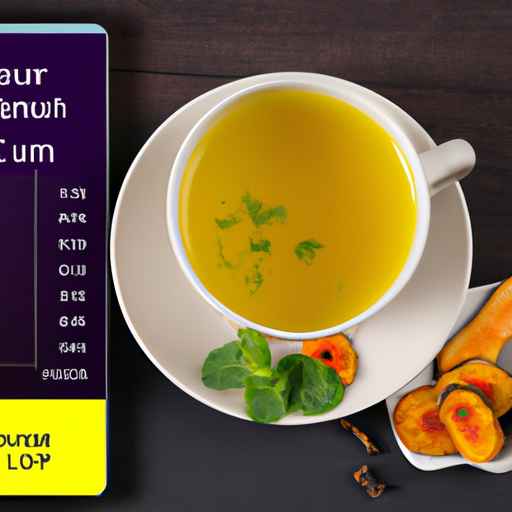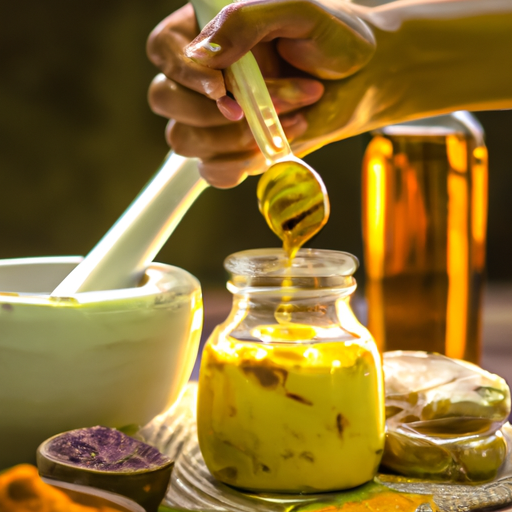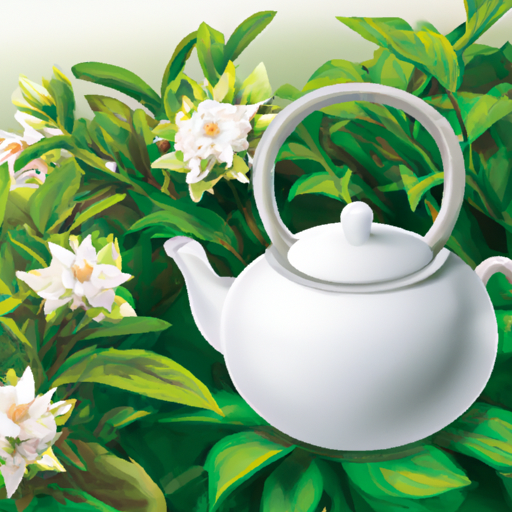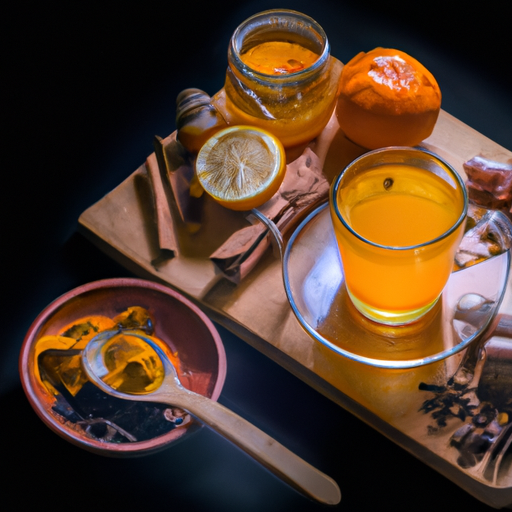Do you enjoy ginger tea and turmeric tea? Both of these teas have a rich history in traditional medicine and are praised for their health benefits. Ginger tea is commonly used to ease digestive problems and decrease inflammation, while turmeric tea is celebrated for its anti-inflammatory properties.
But have you ever wondered if it’s safe to mix these two teas? In this article, we’ll explore the health benefits of ginger and turmeric, their traditional uses in medicine, and the distinct flavors and aromas of each. We’ll also delve into the safety of combining the two teas and the potential benefits of doing so.
Finally, we’ll provide some tips on how to make ginger and turmeric tea and other ways to enjoy these two powerful herbs. So, if you’re curious about mixing ginger and turmeric tea, read on to find out more!
Key Takeaways
- Ginger and turmeric tea offer numerous potential health benefits, such as reducing inflammation and improving digestion.
- Choosing high-quality, fresh ingredients is important for maximum flavor and health benefits.
- It is crucial to use ginger and turmeric in moderation and to consult with a healthcare professional before consuming, especially if you have allergies or are taking medications.
- Regular consumption of ginger and turmeric tea can boost the immune system and reduce chronic inflammation, but it should be enjoyed in reasonable amounts to avoid negative effects.
Health Benefits of Ginger and Turmeric
You can’t go wrong with mixing ginger and turmeric tea – it’s packed with amazing health benefits! Both ginger and turmeric are widely used in traditional medicine, and when combined, they offer a powerful antioxidant and anti-inflammatory effect.
Ginger is known for its ability to soothe digestive issues, reduce nausea and inflammation, and boost the immune system. Turmeric, on the other hand, is famous for its anti-inflammatory and antioxidant properties, thanks to the active ingredient curcumin.
When comparing the health benefits of ginger and turmeric, it’s important to note that both have unique properties that make them valuable additions to your diet.
With all of these benefits, it’s no wonder that ginger and turmeric tea has become a popular choice for those looking to improve their health. But the benefits don’t stop there – the traditional use of ginger and turmeric in medicine has been well-documented, and we’ll explore that next.
Traditional Use of Ginger and Turmeric in Medicine
Historically, both of these root plants have been utilized in traditional medicine for their various health benefits. Ginger and turmeric have been used for centuries in traditional remedies to treat a variety of ailments. Here are some examples of their cultural significance:
- In Ayurvedic medicine, ginger is used to treat digestive issues, inflammation, and respiratory illnesses.
- Turmeric has been used in traditional Chinese medicine to treat conditions such as menstrual cramps, liver problems, and chest pain.
- In Indian medicine, turmeric has been used as an anti-inflammatory and pain reliever.
- Ginger has been used in traditional African medicine to treat stomach problems and as a natural remedy for colds and flu.
- In traditional Jamaican medicine, ginger has been used to alleviate menstrual cramps and as a treatment for asthma.
These traditional uses of ginger and turmeric demonstrate the extensive history of these root plants as medicinal remedies. Despite the lack of scientific evidence to support some of these uses, they’re still widely used in traditional medicine today.
Moving on to the distinct flavors and aromas of ginger and turmeric, it’s important to note that the two are often used together in cooking and beverages. While they both have a slightly spicy and warm flavor, ginger is known for its peppery and slightly sweet taste, while turmeric has a more earthy and slightly bitter taste.
These unique flavors and aromas make ginger and turmeric a popular choice for adding depth and complexity to a variety of dishes and beverages.
Distinct Flavors and Aromas of Ginger and Turmeric
Combining the warm, peppery taste of ginger with the earthy bitterness of turmeric creates a flavor profile that is both complex and harmonious, like a well-orchestrated symphony. Ginger and turmeric have distinct flavors and aromas that complement each other well, making them a popular combination in tea blends.
To create a balanced cup of ginger and turmeric tea, mixing techniques and flavor combinations must be carefully considered. When mixing ginger and turmeric tea, it’s important to understand the balance of flavors that will work best. Ginger has a strong, spicy flavor that can overpower turmeric if used in excess. Turmeric, on the other hand, has a bitter taste that can be unpleasant if not balanced out correctly.
To create a harmonious blend, start with a small amount of ginger and gradually add more until the desired taste is achieved. Experiment with different ratios of ginger and turmeric to discover your ideal blend.
Is it safe to mix ginger and turmeric tea? Let’s explore this question in the next section.
Is it Safe to Mix Ginger and Turmeric Tea?
If you’re wondering whether it’s safe to mix ginger and turmeric tea, there are a few things you should consider.
First and foremost, you should always consult with a medical professional before adding any new supplement to your diet.
Secondly, it’s important to be aware of any allergies or intolerances you may have to these ingredients.
Finally, if you’re taking any medications, it’s important to make sure that there are no potential interactions between the tea and your medication.
Consult with a Medical Professional
Before you mix ginger and turmeric tea, it’s important to consult with a medical professional. The consultation advice and medical supervision are necessary because both ginger and turmeric have medicinal properties that can interact with certain medications and health conditions.
For instance, ginger may interfere with blood clotting, while turmeric can increase the risk of bleeding when taken with blood thinners. Medical supervision is especially important for people with existing health conditions such as diabetes, liver disease, and gallstones, who may experience adverse effects from consuming ginger and turmeric tea.
Additionally, pregnant and breastfeeding women should consult with their healthcare provider before consuming the tea, as it may have adverse effects on them and their babies. Therefore, consulting with a medical professional before consuming ginger and turmeric tea is crucial for ensuring that it is safe for you to consume.
Consider allergies and medications when proceeding with this tea.
Consider Allergies and Medications
Watch out for any allergies or medications that may clash with this powerful potion. Although ginger and turmeric tea has numerous potential health benefits, it may not be suitable for everyone. If you have a known allergy to either ginger or turmeric, then it is best to avoid this tea altogether. Allergic reactions to these spices can range from mild symptoms such as hives and itching to severe reactions like anaphylaxis, which can be life-threatening.
Additionally, if you are taking any medications, you should consult with your healthcare provider before drinking ginger and turmeric tea. These spices can interact with certain medications and cause unwanted side effects. For instance, turmeric may slow blood clotting, which can increase the risk of bleeding when combined with medications that also affect blood clotting. The table below highlights some medications that may interact with ginger and turmeric tea, so it’s essential to discuss any concerns with your healthcare provider.
| Medications that may interact with ginger and turmeric tea |
|---|
| Blood thinners, such as warfarin |
| Diabetes medications, such as insulin |
| High blood pressure medications, such as beta-blockers |
| Antacids, such as omeprazole |
It’s important to consider allergies and medication interactions before drinking ginger and turmeric tea. This potent combination of spices can offer many health benefits, but it’s crucial to ensure it’s safe for you to consume. Once you’ve determined that it’s safe for you to drink, you can reap the rewards of this delicious and healthy beverage.
Benefits of Mixing Ginger and Turmeric Tea
Combining ginger and turmeric in your tea not only enhances the flavor, but also provides a multitude of health benefits such as reducing inflammation and improving digestion. Here are some of the benefits of mixing ginger and turmeric tea:
-
Anti-inflammatory properties: Both ginger and turmeric contain compounds that have anti-inflammatory effects in the body. This can help reduce swelling and pain, making it helpful for conditions like arthritis, asthma, and even heart disease.
-
Digestive aid: Ginger has long been used as a digestive aid, as it can help reduce nausea, bloating, and other digestive issues. Turmeric also has digestive benefits, as it can help stimulate the production of bile, which can aid in digestion.
-
Immune support: Ginger and turmeric both contain compounds that have immune-boosting effects. This can help protect against infections and improve overall health.
-
Antioxidant properties: Both ginger and turmeric contain antioxidants, which can help protect against cell damage and reduce the risk of chronic diseases like cancer.
If you’re looking to reap the benefits of ginger and turmeric tea, it’s important to know how to make it properly. Keep reading to learn more about brewing techniques and other tips for making the perfect cup of ginger and turmeric tea.
How to Make Ginger and Turmeric Tea
If you want to make the best ginger and turmeric tea, you should start by choosing high-quality ingredients. Use fresh ginger and turmeric to ensure that you get the most flavor and health benefits from your tea.
Finally, experiment with different ratios to find the perfect balance that suits your taste. By following these tips, you can create a delicious and nutritious cup of ginger and turmeric tea that’s sure to please.
Choose High-Quality Ingredients
Using fresh and fragrant ginger and turmeric roots will enhance the flavor and aroma of your tea and take it to the next level. When choosing high-quality ingredients for your ginger and turmeric tea, it is important to consider the sourcing options available to you. While conventional grocery stores may offer ginger and turmeric, they may not be as fresh or potent as those found at specialty markets or health food stores.
To ensure that you are using the best possible ingredients for your tea, it is important to look for ginger and turmeric roots that are firm and free of blemishes. Additionally, you should choose organic options whenever possible to avoid exposure to harmful pesticides and chemicals. The following table outlines some key factors to consider when selecting ginger and turmeric for your tea:
| Ginger | Turmeric | |
|---|---|---|
| Color | Pale yellow with brown skin | Bright orange-yellow |
| Texture | Firm and smooth | Firm with knobby appearance |
| Aroma | Spicy and pungent | Earthy and slightly bitter |
Using high-quality ginger and turmeric roots in your tea can make a significant difference in the overall taste and health benefits of your brew. So, next time you’re making ginger and turmeric tea, make sure to choose fresh and organic ingredients for the best possible results.
Use Fresh Ginger and Turmeric
Freshly grated ginger and turmeric will add a burst of flavor and warmth to your cup, elevating your tea-drinking experience to a whole new level. Using fresh ingredients is essential to achieve the full potential of these two powerful roots.
Here are three ways to imagine the aromatic and flavorful combination of ginger and turmeric in your mind:
-
The earthy aroma of freshly grated turmeric mixed with the pungent scent of ginger will awaken your senses and invigorate your soul.
-
The bright yellow color of turmeric mixed with the pale, fibrous strands of grated ginger will create a visually striking and appetizing cup of tea.
-
The spicy, warm taste of ginger will balance the slightly bitter and slightly sweet taste of turmeric, resulting in a perfect harmony of flavors.
To fully maximize the potential of these fresh ingredients, it’s essential to experiment with different brewing methods, flavor combinations, and recipe variations. This will allow you to find the perfect balance of ginger and turmeric in your tea, and create a beverage that suits your personal taste.
Moving forward, let’s explore how to experiment with ratios to create the perfect cup of tea.
Experiment with Ratios
Now that you know to use fresh ginger and turmeric when making tea, it’s time to experiment with ratios. Finding the perfect ratio of ginger to turmeric will depend on your taste preferences.
Some people prefer a stronger ginger taste, while others may prefer a more balanced flavor with equal parts ginger and turmeric. Start by using a 1:1 ratio of ginger and turmeric and adjust from there based on your taste.
If you prefer a stronger ginger taste, add more ginger. If you prefer a milder taste, add more turmeric. The beauty of making tea is that you can adjust the ratios to your liking and make it your own unique blend. Keep experimenting until you find the perfect ratio for you.
Next, we’ll explore other ways to enjoy ginger and turmeric beyond just tea.
Other Ways to Enjoy Ginger and Turmeric
Now that you know how to make ginger and turmeric tea, let’s explore other ways to enjoy these two powerful ingredients.
Fresh juices are a fantastic way to incorporate ginger and turmeric into your daily routine. Smoothies are also a great option, providing a delicious and nutritious way to start your day.
Lastly, don’t forget to experiment with incorporating ginger and turmeric into your cooking. This adds flavor and health benefits to your meals.
Fresh Juices
You can’t go wrong with mixing fresh juices- it’s like a burst of flavor fireworks in your mouth! Not only do they taste amazing, but they are also packed with nutrients that are easily absorbed by your body. Juicing is a great way to incorporate more fruits and vegetables into your diet, and it allows you to experiment with different flavor combinations. Here are some fresh juice recipes that incorporate ginger and turmeric:
| Juice Recipe | Ingredients |
|---|---|
| Ginger Turmeric Carrot Juice | 4 carrots, 1 inch ginger root, 1 inch turmeric root |
| Orange Ginger Turmeric Juice | 4 oranges, 1 inch ginger root, 1 inch turmeric root |
| Pineapple Turmeric Ginger Juice | 1 cup pineapple, 1 inch turmeric root, 1 inch ginger root |
Incorporating fresh juices into your diet not only tastes great, but it also has numerous health benefits. Juicing allows your body to absorb the nutrients from fruits and vegetables more efficiently, and it can help improve digestion, boost your immune system, and increase your energy levels. So why not give one of these recipes a try and see how it makes you feel? Next up, let’s talk about another delicious way to incorporate ginger and turmeric into your diet- smoothies.
Smoothies
If you’re looking for a delicious and convenient way to get some extra nutrients into your diet, smoothies are a great option. Ginger and turmeric smoothies are a fantastic way to incorporate these two powerhouse ingredients into your diet.
Both ginger and turmeric are anti-inflammatory, antioxidant-rich, and have numerous health benefits. Ginger has been shown to help with digestion, reduce nausea and inflammation, and even lower blood sugar levels. Turmeric contains curcumin, a compound with powerful anti-inflammatory properties that can help reduce pain and inflammation.
To make a ginger and turmeric smoothie, simply blend together fresh ginger, fresh turmeric, a banana, some almond milk, and a pinch of cinnamon. You can also add other ingredients like spinach or kale for some extra greens. If you’re looking for more ways to incorporate turmeric into your diet, you can also try making turmeric latte recipes, which are a popular way to enjoy the spice.
Overall, adding ginger and turmeric to your smoothies or cooking is an easy and delicious way to boost your health and wellbeing.
Incorporate into Cooking
Incorporating these two powerful ingredients into your daily cooking routine can add an extra boost of health benefits to your meals. Ginger and turmeric are versatile spices that can be used in a variety of dishes, from savory to sweet.
Here are some cooking tips and recipe ideas to help you get started:
- Use fresh ginger and turmeric in marinades for meats or tofu.
- Add grated ginger and turmeric to stir-fries for a flavorful kick.
- Blend ginger and turmeric into smoothies or juices for a healthy morning drink.
By incorporating ginger and turmeric into your cooking, you can not only add flavor to your meals but also reap their numerous health benefits. However, it’s important to note that these spices should be used in moderation and with caution.
In the next section, we’ll discuss their potential side effects.
Potential Side Effects of Ginger and Turmeric
Before you start drinking ginger and turmeric tea every day, it’s important to consider potential side effects and to enjoy these powerful herbs in moderation.
While there are many benefits to incorporating ginger and turmeric into your diet, excessive consumption can lead to negative effects such as upset stomach or interactions with certain medications.
To ensure that you’re using the right amount of ginger and turmeric in your tea, it’s best to consult with a healthcare professional or follow recommended dosage guidelines.
Benefits of Ginger and Turmeric
You’ll be amazed at the numerous health benefits that ginger and turmeric bring to your body when combined in a tea. Both ginger and turmeric are well-known for their anti-inflammatory properties. Combining them in a tea not only enhances their flavor but also boosts their health benefits.
You can use turmeric supplements or ginger tea bags to make your tea. Alternatively, you can add turmeric milk or ginger shots to your tea to make it more potent. Ginger and turmeric tea can help reduce inflammation in your body, which is linked to various chronic diseases such as heart disease, diabetes, and cancer.
Additionally, both ginger and turmeric are natural pain relievers, making them an excellent choice for people suffering from chronic pain. However, before you start drinking ginger and turmeric tea, it’s essential to consider some safety precautions.
Safety Considerations
Stay safe while enjoying the health benefits of ginger and turmeric by keeping in mind some important considerations.
First, if you have any allergies to either of these spices or to other members of the ginger and turmeric family, it’s important to avoid them altogether. Ginger and turmeric can cause allergic reactions in some people, ranging from mild skin irritation to more serious symptoms such as difficulty breathing and anaphylaxis.
Second, if you’re taking any medications, it’s important to consult with your healthcare provider before adding ginger and turmeric to your diet. Some medications may interact with these spices, including blood thinners and diabetes medications. Ginger and turmeric can also lower blood pressure and blood sugar levels, which can be dangerous for people taking medications for these conditions.
By following these safety considerations, you can enjoy the health benefits of ginger and turmeric without any adverse effects. Enjoying in moderation is the next step to ensure optimal health.
Enjoying in Moderation
To fully experience the benefits of these flavorful spices, it’s important to savor them in moderation, allowing their unique tastes to enhance your favorite dishes. Here are some moderation tips and flavor combinations to keep in mind when enjoying ginger and turmeric tea:
- Start with small amounts of both spices and adjust to taste.
- Try adding a touch of honey or lemon for added sweetness and flavor.
- Experiment with different types of tea, such as green or black tea, to create unique flavor combinations.
- Remember that too much of a good thing can have negative effects on your health, so enjoy in moderation.
By enjoying ginger and turmeric tea in moderation, you can fully appreciate their unique flavors and potential health benefits. But can you drink this tea every day? Let’s explore this question in the next section.
Can I Drink Ginger and Turmeric Tea Every Day?
Is it possible to incorporate ginger and turmeric tea into your daily routine without overdoing it on the health benefits? The answer is yes, but with caution.
While both ginger and turmeric have numerous health benefits, consuming them excessively may lead to potential risks and long-term effects. According to research, ginger and turmeric are generally safe for daily consumption in reasonable amounts.
However, consuming too much ginger may result in heartburn, diarrhea, and stomach upset. On the other hand, excessive intake of turmeric may lead to liver problems and gallbladder issues. Therefore, it’s important to consume ginger and turmeric tea in moderation and consult with your healthcare provider if you have any underlying medical conditions.
In the next section, we’ll discuss how much ginger and turmeric you should use in your tea to ensure a safe and beneficial consumption.
How Much Ginger and Turmeric Should I Use in my Tea?
Enjoy a safe and beneficial consumption of ginger and turmeric tea by knowing how much of these ingredients to use in your daily brew. The tea ratio is important to consider when making ginger and turmeric tea. A good rule of thumb is to use one teaspoon of grated ginger and one teaspoon of grated turmeric for every cup of water. However, you can adjust the ratio to your liking, depending on how strong you want your tea to be.
Brewing time is also crucial in making ginger and turmeric tea. After bringing the water to a boil, let the tea steep for at least 10 minutes to allow the flavors to infuse. You can also add honey or lemon to enhance the taste.
Remember to drink the tea while it’s still warm to maximize its benefits.
With these tips, you can enjoy a delicious and healthy cup of ginger and turmeric tea every day.
What’re the health benefits of drinking ginger and turmeric tea? Let’s find out.
What Are the Health Benefits of Drinking Ginger and Turmeric Tea?
Indulging in a warm cup of ginger and turmeric tea can provide you with a plethora of health benefits. These two spices have been used for centuries for their medicinal properties.
Ginger has anti-inflammatory properties that can help reduce pain and swelling in the body. Turmeric, on the other hand, contains a powerful antioxidant called curcumin, which has been shown to have immune system support.
When combined, ginger and turmeric can work together to create a powerful anti-inflammatory and immune-boosting blend. Research has shown that regular consumption of ginger and turmeric tea can help reduce chronic inflammation, which is linked to many chronic diseases such as heart disease and cancer.
Additionally, this tea can help support your immune system by boosting the production of white blood cells, which are responsible for fighting off infections and diseases. So, if you’re looking for a natural way to reduce inflammation and boost your immune system, incorporating ginger and turmeric tea into your daily routine may be a great option.
Frequently Asked Questions
Can ginger and turmeric tea be consumed during pregnancy?
You can consume ginger and turmeric tea during pregnancy for its numerous benefits. Ginger helps with nausea and vomiting, while turmeric is a natural anti-inflammatory. There are many recipes available online to make this tea.
Is it safe to mix ginger and turmeric tea with other herbs or supplements?
Mixing ratios and flavor combinations can be safe as long as the herbs and supplements are compatible. Consult with a healthcare professional to ensure safety and effectiveness. Evidence-based research supports the benefits of ginger and turmeric tea.
Can ginger and turmeric tea interact with certain medications?
It’s important to be cautious when using herbal remedies like ginger and turmeric tea alongside medications, as they may interact and pose health risks. Always consult with your healthcare provider before trying alternative treatments.
How much ginger and turmeric should be used to make tea for optimal health benefits?
To maximize health benefits, aim for a ginger turmeric ratio of 1:1. Use 1-2 teaspoons of each per cup of water and brew for at least 10 minutes. Allegorically speaking, balance is key for this powerful tea.
Can ginger and turmeric tea be consumed cold or must it be consumed hot?
Yes, ginger and turmeric tea can be consumed cold or hot depending on your preference. Both methods provide health benefits. Cold tea can be made by steeping the herbs overnight in water and straining. Hot tea can be made by boiling the herbs in water for a few minutes.
Conclusion
So, can you mix ginger and turmeric tea? Yes, you can! Doing so can provide a variety of health benefits, including reducing inflammation, boosting immunity, and improving digestion. However, it’s important to consider any potential side effects and consult with a healthcare professional before adding ginger and turmeric to your daily routine.
Overall, ginger and turmeric are powerful herbs with a long history of use in traditional medicine. They offer distinct flavors and aromas that can be combined to create a delicious and healthy tea. Whether you’re looking to improve your overall health or simply enjoy a flavorful beverage, ginger and turmeric tea is a great option to consider.
So, why not give it a try and see how it benefits your body and mind?










